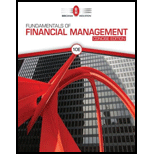
To identify: The four financial statements contained in most annual reports.
Introduction:
Annual Report: A detailed report that presents a company’s activities during a particular period that is its accounting period is called annual report. It is used by the stockholders of the company and the general public to evaluate the company’s performance and financial position.
Answer to Problem 1Q
The four financial statements contained in annual reports are
Explanation of Solution
- Balance sheet reports the total liabilities, total assets and total stockholders’ equity at a specified date that is the last day of accounting period for a company.
- Income statement reports the expenses and income of a company for the accounting period.
- Statement of cash flow reports the generated net amount of cash or consumed in the accounting period by a company.
- Statement of stockholders’ equity reports the opening and closing balance of stockholders’ equity with the changes incurred during that particular accounting period.
So, the four financial statements contained in annual reports are balance sheet, income statement, statement of cash flow and statement of stockholders’ equity.
Want to see more full solutions like this?
Chapter 3 Solutions
Fundamentals Of Financial Management, Concise Edition (mindtap Course List)
- Ned assistance with Q3 and Q4 below? Cost of Equity The earnings, dividends, and stock price of Shelby Inc. are expected to grow at 6% per year in the future. Shelby's common stock sells for $21 per share, its last dividend was $1.00, and the company will pay a dividend of $1.06 at the end of the current year. Using the discounted cash flow approach, what is its cost of equity? Round your answer to two decimal places. 11.06 % If the firm's beta is 1.3, the risk-free rate is 8%, and the expected return on the market is 11%, then what would be the firm's cost of equity based on the CAPM approach? Round your answer to two decimal places. 11.90% If the firm's bonds earn a return of 9%, then what would be your estimate of rs using the own-bond-yield-plus-judgmental-risk-premium approach? (Hint: Use the mid-point of the risk premium range.) Round your answer to two decimal places. % On the basis of the results of parts a–c, what would be your estimate of Shelby's cost of equity?…arrow_forwardWhat monthly compounded interest rate would Second National Bank need to pay on savings deposits to provide an effective rate of 6.2%?arrow_forwardDont solve with assumption dataarrow_forward
- Yan Yan Corp. has a $2,000 par value bond outstanding with a coupon rate of 4.7 percent paid semiannually and 13 years to maturity. The yield to maturity of the bond is 5.05 percent. What is the dollar price of the bond?arrow_forwardA trip goa quesarrow_forwardWhat is the benefit of the finance subject? explain.arrow_forward
 Intermediate Financial Management (MindTap Course...FinanceISBN:9781337395083Author:Eugene F. Brigham, Phillip R. DavesPublisher:Cengage LearningCentury 21 Accounting Multicolumn JournalAccountingISBN:9781337679503Author:GilbertsonPublisher:Cengage
Intermediate Financial Management (MindTap Course...FinanceISBN:9781337395083Author:Eugene F. Brigham, Phillip R. DavesPublisher:Cengage LearningCentury 21 Accounting Multicolumn JournalAccountingISBN:9781337679503Author:GilbertsonPublisher:Cengage College Accounting (Book Only): A Career ApproachAccountingISBN:9781337280570Author:Scott, Cathy J.Publisher:South-Western College PubPrinciples of Accounting Volume 1AccountingISBN:9781947172685Author:OpenStaxPublisher:OpenStax College
College Accounting (Book Only): A Career ApproachAccountingISBN:9781337280570Author:Scott, Cathy J.Publisher:South-Western College PubPrinciples of Accounting Volume 1AccountingISBN:9781947172685Author:OpenStaxPublisher:OpenStax College





